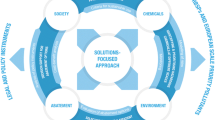Abstract
The regulation of chromium in drinking water and sludge illustrates some of the challenges of regulating a chemical with complex environmental chemistry in a dynamic regulatory environment. The controversies evoked in setting environmental standards for chromium reflect technical uncertainties and the conflicting values of affected parties including regulators, citizens potentially exposed to chromium pollution, polluting industries, and research scientists. Regulatory limits for chromium in water and sludge recognize the paradoxical nature of chromium chemistry but also illustrate how the use of risk assessment can alter the regulatory approach. The framework of rationality as described by Crawford-Brown is suggested as a useful tool for evaluating regulatory limits for environmental contaminants. Science-based policies are most rational when they reflect the characteristics of rationality with respect to the ends or objectives sought, the means chosen to achieve these ends, and the beliefs that substantiate the chosen means and ends. If scientific research is to be applied to regulatory or environmental policy questions, then the traditional focus on the rationality of empirically based scientific beliefs must be expanded to consider the focus of the research question and the methodologies used.
Similar content being viewed by others
References
Agency for Toxic Substances and Disease Registry (1993) Toxicological profile for chromium. U.S. Department of Health and Human Services, TP-92/08
Anderson RA (1989) Essentiality of chromium in humans. Sci Total Environ (Special issue: The chromium paradox in modern life) 86: 75–81
Anderson RS (1996) Chromium: an essential carcinogen. In: Proccedings of the Chromium Symposium 1986: an update. Industrial Health Foundation, Inc., Arlington, Va.
Bartlett RJ, James BR (1979) Behavior of chromium in soils. III. Oxidation. J Environ Qual 8: 31–35
Bartlett RJ (1986) Chromium oxidation in soils and water: measurements and mechanisms. In: Proceedings of the Chromium Symposium: an update. Industrial Health Foundation, Pittsburgh, Pa.
Bartlett RJ (1991) Chromium cycling in soils and water: links, gaps, and methods. Environ Health Perspect 92: 17–24
Brinton WF (1995) Deconstruction is compost maturity. Biocycle Dec., pp 83–84
Bunge M (1987) Seven desiderata for rationality. In: Agassi J, Jarvie I (eds) Rationality: the critical view. Martinus Nijhoff, Dordrecht, The Netherlands
Carrington CD (1997) An administrative view of model uncertainty in public health. Risk Health Safety Environ 8: 273–286
Cohen MD et al. (1993) Mechanisms of chromium carcinogenicity and toxicity. Crit Rev Toxicol 23: 255–281
Crawford-Brown DJ, Brown KG (1992) Hazard identification in carcinogen risk analysis. Kenneth G. Brown Inc., Chapel Hill, N.C.
Eastern Research Group (1992) Technical support document for land application of sewage sludge, vol 1. U.S. Environmental Protection Agency, Office of Water, Office of Science and Technology, EPA 822-R-93-002
Fendorf SE (1995) Surface reactions of chromium in soils and waters. Geoderma 67: 55–71
Finkel AM (1990) Confronting uncertainty in risk management: a guide for decision makers. Center for Risk Management, Resources for the Future, Washington, DC
Goldhaber S, Vogt C (1989) Development of the revised drinking water standard for chromium. Sci Total Environ 86: 43–51
Hem JH (1989) Study and interpretation of the chemical characteristics of natural water. U.S. Geological Survey No. 2254
James BR, Bartlett RJ (1983) Behavior of chromium in soils. VI. Interactions between oxidation-reduction and organic complexation. J Environ Qual 12: 173–176
James BR (1992) The uses and misuses by regulatory agencies of the research of Bruce James on the redox chemistry of chromium in soils. In: Hexavalent Chromium Analytical Methods Workshop. Industrial Health Foundation, Inc., Arlington, Va.
James BR (1996) Personal communication, University of Maryland at College Park
James BR et al (1997) Oxidation-reduction chemistry of chromium: relevance to the regulation and remediation of chromate -contaminated soils. J Soil Contam 66: 569–580
Longino HE (1990) Science as social knowledge. Princeton University Press, Princeton, N.J.
Maxwell N (1984) From knowledge to wisdom. Basil Blackwell Publ. Ltd., London
Nieboer E, Shaw SL (1988) Mutagenic and other genotoxic effects of chromium compounds. In: Nriagu JO, Nieboer E (eds) Chromium in the natural and human environments. Wiley, New York
NOFA-NH (Nottingham Organic Farmers Association of New Hampshire) (1993) BiosolidspSludgepBe Aware. Concord, N.H.
Palmer CD, Puls RW (1994) Natural attenuation of hexavalent chromium in ground water and soils. U.S. Environmental Protection Agency, Office of Water, EPA/540/S-94/505
Popper KR (1994) The myth of the framework: In: Defence of science and rationality. Routledge, London, pp 104
Schardt D, Schmidt S: Chromium. Nutr Act Health Lett 23: 10–11
Southworth RM (1996) Comments on sludge regulations for chromium. U.S. EPA, Bioremediation Office, New Jersey
Thompson PB (1996) Pragmatism and policy: the case of water. In: Light A, Katz E (eds) Environmental pragmatism. Routledge, London
U.S. EPA (1991) Rules and regulations: final rule. Federal Register 56: 3527
U.S. EPA (1991) Rules and regulations: Chromium (III) compounds; toxic chemical release reporting; community right-to-know. U.S. Environmental Protection Agency, Federal Register 56, 226: 58859–58862
U.S. EPA (1992) Integrated Risk Information System (IRIS) for Chromium (III): health assessment. http://www.epa.gov/ngispgm3/iris/irisdat/0028.DAT
U.S. EPA (1994) National primary drinking water regulations. Disinfectants and disinfection byproducts; proposed rule. Fed Register 59: 38668–38829
U.S. EPA (1994) Drinking water regulations and health advisories. U.S. Environmental Protection Agency, Office of Water, EPA 822-R-94-001
U.S. EPA (1995) Rules and regulations: standards for the use or disposal of sewage sludge; final rule and proposed rule — 40CFR Parts 403 and 503. U.S. Environmental Protection Agency, Federal Register 60, 206: 54763–54770 (Online via GPO access [wais.access.gpo.gov])
Yassi A, Nieboer E (1988) Carcinogenicity of chromium compounds. In: Nriagu JO, Nieboer E (eds) Chromium in the natural and human environments. Wiley, New York
Author information
Authors and Affiliations
Rights and permissions
About this article
Cite this article
Bartlett, L., Vesilind, P.A. Chemistry and controversy: the regulation of environmental chromium. Environmental Engineering and Policy 1, 81–86 (1998). https://doi.org/10.1007/s100220050008
Received:
Published:
Issue Date:
DOI: https://doi.org/10.1007/s100220050008




